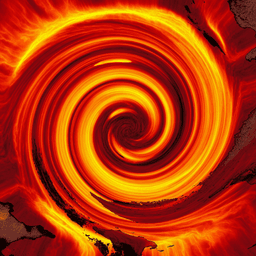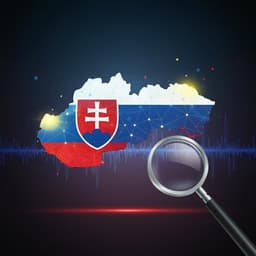
Earth Sciences
Summer heat wave in 2022 led to rapid warming of permafrost in the central Qinghai-Tibet Plateau
X. Zhu, T. Wu, et al.
Discover how extreme summer heatwaves are reshaping the permafrost environment in the Qinghai-Tibet Plateau. Research from Xiaofan Zhu and colleagues reveals that the summer of 2022 brought unprecedented changes, with active layer thickness soaring 20% above the average, highlighting the profound impacts of climate events on permafrost stability.
~3 min • Beginner • English
Introduction
Permafrost, defined as ground that remains at or below 0 °C for at least two consecutive years, exerts major hydrological, ecological, and environmental influences. While long-term warming is known to drive permafrost degradation, short-lived extremes such as heat waves can also alter ground thermal regimes by increasing temperatures, melting ground ice, and modifying buffer layers (e.g., snow, vegetation). In 2022, unprecedented Northern Hemisphere summer heat waves occurred, with many regions exceeding 40 °C and anomalies 2–4 °C above average. This study examines whether similar extreme summer conditions affected the central Qinghai-Tibet Plateau (QTP), how the active layer and permafrost responded (e.g., thicker active layer, higher permafrost temperature), spatial differences in response across monitored sites, and to what extent heat waves contributed to seasonal active-layer thaw depth. The work combines long-term in situ monitoring (six active-layer sites and three permafrost boreholes), field surveys, and reanalysis data to address these questions and improve understanding and modeling of permafrost under extreme events.
Literature Review
Prior research on extreme-event impacts on permafrost encompasses: (1) thermal state changes, where extreme heat can raise ground temperatures, melt ground ice, and trigger linked hazards such as snow droughts or wildfires that alter surface buffering; (2) disaster mechanisms, with heat waves linked to rockfalls, slope failures, and landslides in temperature-sensitive, ice-rich alpine permafrost due to shallow ice melt and reduced slope stability; and (3) ecosystem impacts, where extreme winter warming reduces subsequent summer plant root growth and productivity and inhibits soil fauna, bryophytes, and lichens in sub-Arctic regions. Despite these advances, processes by which extreme events affect active-layer and permafrost thermal states at seasonal to interannual scales remain uncertain. The 2022 mega-heatwave provides a salient case to investigate these mechanisms over the QTP.
Methodology
Study area and observations: Six active-layer monitoring sites (China01, China04, China06, QT01, QT06, QT09) and three permafrost boreholes (QTB01, QTB06, QTB09) in the central QTP (>4500 m a.s.l.) were used. Vegetation is mainly alpine steppe and alpine meadow. Soil temperature and moisture in the active layer were recorded with thermocouples (±0.1 °C) and Stevens Hydro probes (±3%), and borehole ground temperatures with calibrated thermistor strings (±0.1 °C). Data were logged every 30 minutes (CR10X/CR3000). Site metadata include MAAT, MAGT, ALT, vegetation type, and monitoring depths/time series (Table 1 in paper).
Meteorological data and indices: ERA5-Land daily air temperature (1961–2022) provided mean summer air temperature (SAT, June–August) and degree days thawing (DDT; sum of positive daily air temperatures during thaw season). ERA5-Land performance was evaluated against in situ observations and found reliable for air temperature, especially in summer. A national long-term daily snow depth dataset (1979–2023) was used for snow assessment.
Derived permafrost metrics: Active Layer Thickness (ALT) was determined from the maximum depth of the 0 °C isotherm inferred from observed soil temperatures each year. Mean Annual Ground Temperature (MAGT) was computed at the depth of zero annual amplitude (DZAA) using daily ground temperature profiles.
ALT gap filling with Stefan model: Where ALT could not be determined due to gaps, a simplified Stefan formulation was applied. The classical Stefan solution uses ALT = sqrt(2 k DDT / (ρ ω L)), but the study adopts a simplified linearized form ALT = E × DDT, where E aggregates edaphic factors (unfrozen thermal conductivity, soil moisture and latent heat of fusion, and soil dry density). E was calibrated using years with observations at each site (observed ALT and corresponding DDT), then assumed constant for years with missing data, and applied with ERA5-Land DDT to estimate ALT. Validation against observed ALT yielded R² ≈ 0.90, RMSE ≈ 12.96 cm, MAE ≈ 10.31 cm, supporting reliability for gap filling.
Heat-wave contribution to seasonal thaw depth: The seasonal thaw depth in a year was partitioned into a component due to regular seasonal variations (TDN_HW) and a component attributable to heat-wave events (TDHW). Heat-wave days were identified per WMO criteria (daily maximum > climatological average maximum by >5 °C for ≥5 consecutive days). To estimate TDN_HW, temperature series for heat-wave days were replaced by the multi-year daily averages for those calendar days (non-heat-wave conditions), and the Stefan model was run to obtain TDN_HW. The heat-wave-induced thaw depth was TDHW = ALT − TDN_HW. The contribution fraction (%) = (TDHW / ALT) × 100 was computed annually for each site.
MAGT drivers: Multiple linear regression related MAGT to DDT and degree days freezing (DDF) at same year and with lags (up to four years) using eight candidate models that included contemporaneous and lagged sums/terms of DDT and DDF. Vegetation, snow, soil texture, and soil moisture were acknowledged as important but lacked continuous time series and were not included in regressions.
Statistical analyses: Pearson correlation provided correlation coefficients (R). Linear trends were estimated by least squares; significance was tested with the Mann–Kendall test. Errors were quantified with RMSE and MAE. Topographic variables (altitude, slope, aspect) were derived from SRTM DEM by bilinear interpolation to sites. Vegetation coverage and biomass (above/below ground) were obtained from field surveys (2013–2023). Soil organic matter was measured via dichromate oxidation of sampled soils.
Key Findings
- The study area experienced a pronounced summer 2022 heat wave: mean SAT at all sites reached the highest values in the 1961–2022 record; warming trends in mean SAT were 0.17–0.34 °C per decade; 2022 mean SAT was about 3.2 °C above the 1961–1990 reference period.
- DDT increased significantly (1961–2022 trends: 24.28–38.56 °C·day per decade). The 2022 DDT averaged 715 °C·day versus a 1961–2021 mean of 450.6 °C·day (≈1.6× higher), raising the overall 1961–2022 trend by ~10% compared to 1961–2021.
- Active layer warming and deepening: At four sites (China06, QT01, QT06, QT09) summer ground temperatures in 2022 were 0.1–2.0 °C higher than previous years down to ~140–210 cm, with the largest differences near the surface (0–50 cm ≈ +1.5 °C on average). China01 showed 2022 warming at 50–120 cm; China04 did not show anomalous 2022 summer ground temperatures versus prior years.
- ALT trends (2000–2022) increased at all sites, markedly at China06, QT01, QT06, QT09 with rates 16.26, 14.85, 17.49, and 11.23 cm per decade, exceeding rates reported for the Arctic (1.5 cm per decade, 1990–2019) and Northern Hemisphere (6.5 cm per decade, 2000–2018). Maximum ALT at these four sites occurred in 2022, exceeding 2000–2021 means by 26.7–37.9 cm (mean ALT 2000–2021: 175.9 cm; 2022 mean at these sites: 207.7 cm, ~20% higher).
- Permafrost thermal state: In boreholes QTB01, QTB06, and QTB09, 2022 had the highest shallow ground temperatures and thaw depths. 2022 MAGT values were the highest on record: −0.26 °C (QTB01), −0.24 °C (QTB06), and −2.34 °C (QTB09), averaging ~10% warmer than previous-year means. MAGT trends remained significantly increasing whether 2022 was included or excluded, with rates on the order of 0.088, 0.139, and ~0.289–0.298 °C per decade depending on inclusion of 2022.
- Quantified heat-wave contribution: Mean contribution fractions of heat waves to seasonal thaw depth (2000–2022) ranged 6.6%–13.6% across sites, with China06 (13.6% ± 6.6%), QT09 (11.8% ± 6.1%), and China01 (11.1% ± 4.4%) exceeding 10%. All six sites reached their maximum contribution fraction in 2022: China01 22.8%, China06 31.3%, QT01 20.9%, QT09 28.9%, China04 12.4%, QT06 14.5%. The 2022 average contribution (21.8%) was 2.3× the 2000–2021 average (9.5%). Contribution fraction trends increased at all sites (≈1.77%–4.52% per decade; several significant at p<0.05).
- Drivers of spatial differences: China04, with highest vegetation coverage, biomass, and soil organic matter (110.2 ± 73.7 g·kg−1), and observed ground ice near the permafrost table, showed muted sensitivity to the 2022 heat wave, whereas drier, sparsely vegetated sites (e.g., China06) were more climate-dominated. Snow depth was thin (mean annual 0.33–0.46 cm; max daily <2 cm) with short duration, implying limited buffering effect.
Discussion
The findings confirm that a regionally pervasive summer 2022 heat wave substantially enhanced energy inputs to the ground, leading to record-high summer air and ground temperatures, deeper seasonal thaw, and elevated MAGT. However, responses varied markedly among sites. Where vegetation cover and biomass were high and soils rich in organic matter (e.g., China04), canopy shading, evapotranspiration, and organic-layer thermal buffering, along with latent heat consumption from ground ice, reduced the translation of atmospheric heat anomalies into deeper thaw. Conversely, at sparsely vegetated, drier, coarser-textured, and climate-exposed sites (e.g., China06, QT06), air temperature and thawing degree-day anomalies more effectively propagated downward, maximizing ALT and contribution fractions in 2022. Snow cover exerted limited control due to overall thin and short-lived snowpacks in the study area, while topographic influences (altitude, slope, aspect) contributed second-order effects consistent with known patterns (higher altitude and steeper slopes associated with shallower ALT; aspect effects weak here). MAGT increases likely reflect both the extreme 2022 summer and cumulative multi-year thermal inertia, with winter warming and limited snow buffering also important. These results address the research questions by demonstrating the presence of the 2022 heat wave in the central QTP, quantifying its amplified impacts on active layer and permafrost, revealing significant spatial heterogeneity in responses, and providing a physics-based estimate of the heat-wave contribution to seasonal thaw depth. The relevance to the field lies in explicitly linking extreme-event thermodynamics to permafrost metrics using observations and a parsimonious Stefan framework, thereby informing model development and risk assessment for permafrost stability and related hazards.
Conclusion
This study demonstrates that the 2022 summer heat wave substantially accelerated active-layer thaw and warmed permafrost across the central QTP, producing record-high SAT, DDT, ALT (at four sites), and MAGT (at three boreholes). Using a simplified Stefan approach, the study quantifies that heat waves contributed on average 6.6%–13.6% to seasonal thaw depth over 2000–2022, with a marked peak in 2022 (site maxima 12.4%–31.3%; overall average 21.8%). Spatial variability in responses is governed by interacting climate, vegetation, soil, and topographic factors, with vegetation cover, biomass, soil organic matter, soil moisture distribution, and subsurface ground ice modulating sensitivity to extreme heat, and snow exerting little influence due to thin, transient cover. These insights improve mechanistic understanding of how short-term extremes superimpose on long-term warming to affect permafrost. Future research should: (1) integrate co-monitoring of ALT and ground subsidence to capture thermokarst-related volume change; (2) extend continuous observations of vegetation, snow, soil moisture/texture to include in predictive models of MAGT and ALT; (3) refine and validate physics-based models to explicitly incorporate extreme-event forcing; and (4) examine response differences across broader permafrost types and regions to generalize heat-wave impacts.
Limitations
- ALT gap-filling assumes a site-specific, time-invariant edaphic factor (E) in the simplified Stefan model; temporal changes in soil properties or moisture are not explicitly accounted for. Although validation showed high skill (R² ≈ 0.90), uncertainties remain.
- Heat-wave contribution estimates rely on substituting heat-wave days with climatological daily means to construct a no-heat-wave scenario; this assumes linear separability and does not capture all nonlinear land–atmosphere feedbacks.
- ERA5-Land air temperatures, while validated and generally reliable in summer, still introduce reanalysis uncertainties; ERA5-Land soil temperatures are known biased in the QTP and were not used for ALT retrieval without caution.
- MAGT regression analyses exclude vegetation, snow, soil texture, and moisture due to lack of continuous time series, potentially omitting key drivers.
- Snow depth is thin and short-lived in the region; site-level snow process characterization is limited, which may affect interpretation of snow–ground thermal coupling.
- Monitoring does not directly measure ground subsidence; ALT alone may underrepresent net thaw-related ground changes in ice-rich terrains.
- The study focuses on a subset of sites in the central QTP; generalizability to other permafrost settings should be made cautiously.
Related Publications
Explore these studies to deepen your understanding of the subject.







